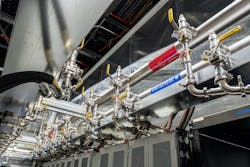Equinix plans to expand support for advanced liquid cooling technologies—like direct-to-chip—to over 100 of its International Business Exchange® (IBX®) data centers in more than 45 metros worldwide.
This builds on Equinix's existing offering that supports liquid-to-air cooling through in-rack heat exchangers at nearly every IBX today.
By making this expansion, more businesses can use the most performant cooling technologies for the powerful, high-density hardware that supports compute-intensive workloads like artificial intelligence (AI).
"Liquid cooling is revolutionizing how data centers cool, powerful, high-density hardware that supports emerging technologies, and Equinix is at the heart of that innovation," said Tiffany Osias, VP of Global Colocation, Equinix. "We have been helping businesses with significant liquid-cooled deployments across various deployment sizes and densities for years.”
A partnership approach
Customers who have already commercialized direct-to-chip liquid cooling support in more than 45 metros—including London, Silicon Valley, Singapore, and Washington D.C.—can deploy advanced liquid cooling solutions against mission-critical needs in the markets that matter most to them.
Equinix provides direct access to the ecosystem of partners and providers of Platform Equinix®. By continuing this approach, Equinix is committed to empowering digital leaders with the ability to evolve their next-generation liquid-cooled designs.
Multiple options
Equinix supports major liquid cooling technologies, including direct-to-chip and rear-door heat exchangers, so customers can take advantage of the most efficient solutions. Additionally, Equinix offers a vendor-neutral approach to enable customers to use their preferred hardware provider in their deployments.
Direct-to-chip is an approach that involves a cold plate sitting on top of the chip inside the server. The cold plate is enabled with liquid supply and return channels, allowing technical cooling fluid to run through the plate, drawing heat away from the chip. This allows direct-to-chip-enabled servers to be installed in a standard IT cabinet like legacy air-cooled equipment, even while being cooled innovatively.
Rear-door heat exchangers use a cooling coil and fans to capture heat from air-cooled IT equipment. They are mounted directly onto customer cabinets to manage higher cooling loads than conventional cooling.
Liquid cooling was a crucial element in developing the development of the Open19 V2 specification. The goal of the Open19 project, which operates under the Linux Foundation, was to create an open standard that can fit any 19" rack for server, storage, and networking.
Companies now have the option to use hardware from a diverse set of vendors in any data center environment.
“Equinix's technology and vendor-neutral approach to liquid cooling is a mechanism to remove the friction of deploying advanced liquid cooling solutions in enterprise data centers,” said My Truong, SSIA Chairperson and Field CTO for Equinix.
For related articles, visit the Data Center Test Topic Center
For more information on optical components and suppliers, visit the Lightwave Buyer’s Guide.
To stay abreast of optical communications technology, subscribe to Lightwave’s Enabling Technologies Newsletter.

Sean Buckley
Sean is responsible for establishing and executing the editorial strategies of Lightwave and Broadband Technology Report across their websites, email newsletters, events, and other information products.

